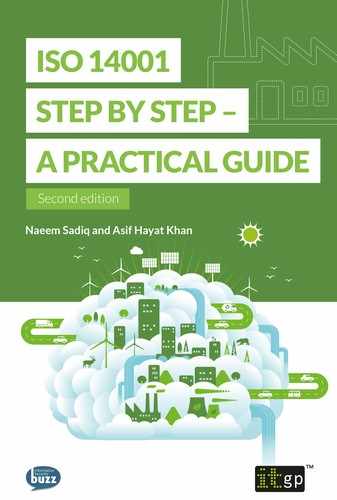CHAPTER 8: EMERGENCY PREPAREDNESS AND RESPONSE (CLAUSE 8.2)
Summary of requirements
The organisation shall establish and implement procedure(s) that identify potential emergency situations (that could negatively affect the environment), and define mechanisms to respond to these situations. These actions must include mitigation of any adverse environmental impacts.
The organisation must also periodically review and test these procedures.
How can these requirements be met?
There are two main components to Clause 8.2: ‘preparedness’ and ‘response’.
Preparedness
• With a group of individuals from various functional areas in the organisation, it is important to brainstorm possible accidents and emergencies that could have environmental impacts.
• Review incident records for past years. Also review the environmental aspects list for potential emergencies under abnormal operating conditions. Environmental emergencies/accidents might include:
![]() A hazardous gas leak;
A hazardous gas leak;
![]() Unplanned emissions or effluent discharges;
Unplanned emissions or effluent discharges;
![]() A spill;
A spill;
![]() Failure of a tank, dam, equipment or structure;
Failure of a tank, dam, equipment or structure;
![]() A natural disaster, e.g. lightning, earthquake, flood or extreme weather;
A natural disaster, e.g. lightning, earthquake, flood or extreme weather;
![]() A crash or collision;
A crash or collision;
![]() Sabotage, vandalism, terrorist attack, bomb threat or a riot; and
Sabotage, vandalism, terrorist attack, bomb threat or a riot; and
![]() Any other impact arising out of hazardous substances handled, stored and/or used in the organisation.
Any other impact arising out of hazardous substances handled, stored and/or used in the organisation.
• Identify and list all potential emergencies and accidents that the organisation might encounter.
• Determine what is required to respond to these emergency situations. This could include establishing and implementing the following:
![]() An emergency response plan, including roles and responsibilities.
An emergency response plan, including roles and responsibilities.
![]() The resources and equipment needed to respond to and to prevent or mitigate associated environmental impacts. These could include spill kits to contain the spread of harmful liquids, suction pumps, equipment for removal of contaminated soil, and so on.
The resources and equipment needed to respond to and to prevent or mitigate associated environmental impacts. These could include spill kits to contain the spread of harmful liquids, suction pumps, equipment for removal of contaminated soil, and so on.
![]() Emergency procedures that must be adopted throughout the organisation.
Emergency procedures that must be adopted throughout the organisation.
![]() Training personnel on emergency procedures and actions.
Training personnel on emergency procedures and actions.
![]() Emergency information and communication processes, which may include maps/drawings of electrical cabling, gas pipes, underground tanks, storm water channels, containment pits, and so on.
Emergency information and communication processes, which may include maps/drawings of electrical cabling, gas pipes, underground tanks, storm water channels, containment pits, and so on.
![]() The liaison and support needed from external agencies, such as the police, fire brigade, hospitals and concerned environmental agencies.
The liaison and support needed from external agencies, such as the police, fire brigade, hospitals and concerned environmental agencies.
• Locations where an emergency could occur should be mapped and have emergency equipment nearby.
• Neighbourhood areas vulnerable to gas escape or other consequences of an emergency at the facility should also be identified and marked on a map for rapid notification and other relief/mitigation actions. Prevailing wind directions should be mapped to identify the potential downwind areas. Sensitive areas in the vicinity may include residential, industrial, agricultural, recreation, fishing areas or sanctuaries.
• Emergency exits and muster points should be identified and marked.
Response
ISO 14001 requires organisations to respond to accidents or emergencies by taking actions that prevent or mitigate associated adverse environmental impacts. Effective response requires not just preparedness, but also rehearsals and drills of the procedures to make sure that:
• The procedures are adequate and can effectively respond to a real emergency or accident;
• All persons understand their roles and know how to perform them in emergency situations; and
• The emergency equipment is tested and the results of the tests are reported.
An organisation must test its emergency procedures by simulating relevant kinds of emergencies under conditions that are as realistic as possible. Such drills do not have any learning value unless they are closely monitored against their key performance parameters, e.g. response time, ability to contain a spill, fire-fighting, effectiveness of equipment, ability to evacuate and effectiveness of mitigation measures. Results of such drills must be maintained and analysed for further improvement of the emergency response system.
Organisations must review their emergency procedures at planned intervals and after an accident or emergency. This ensures the emergency preparedness and response procedures remain adequate and suitable.
